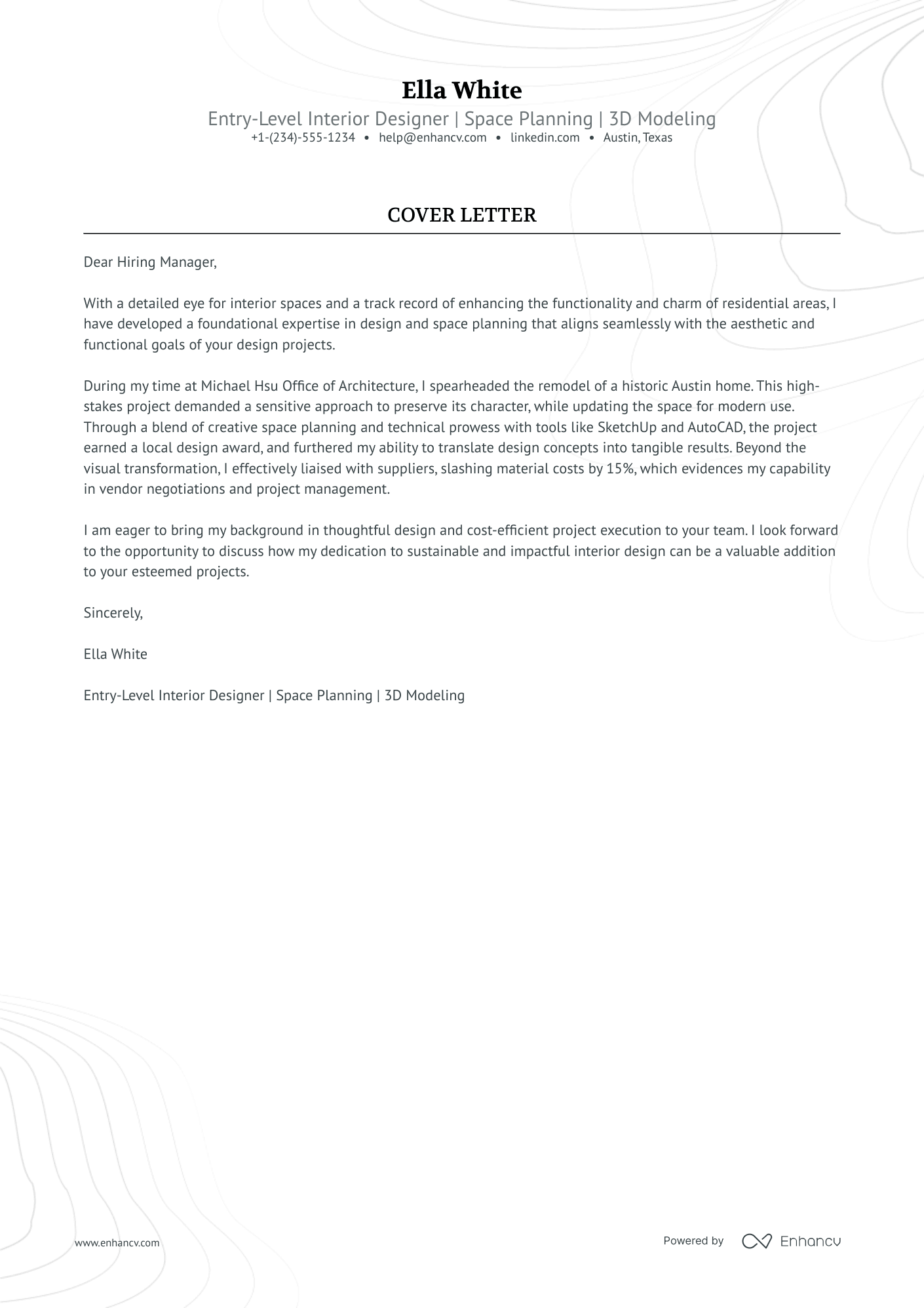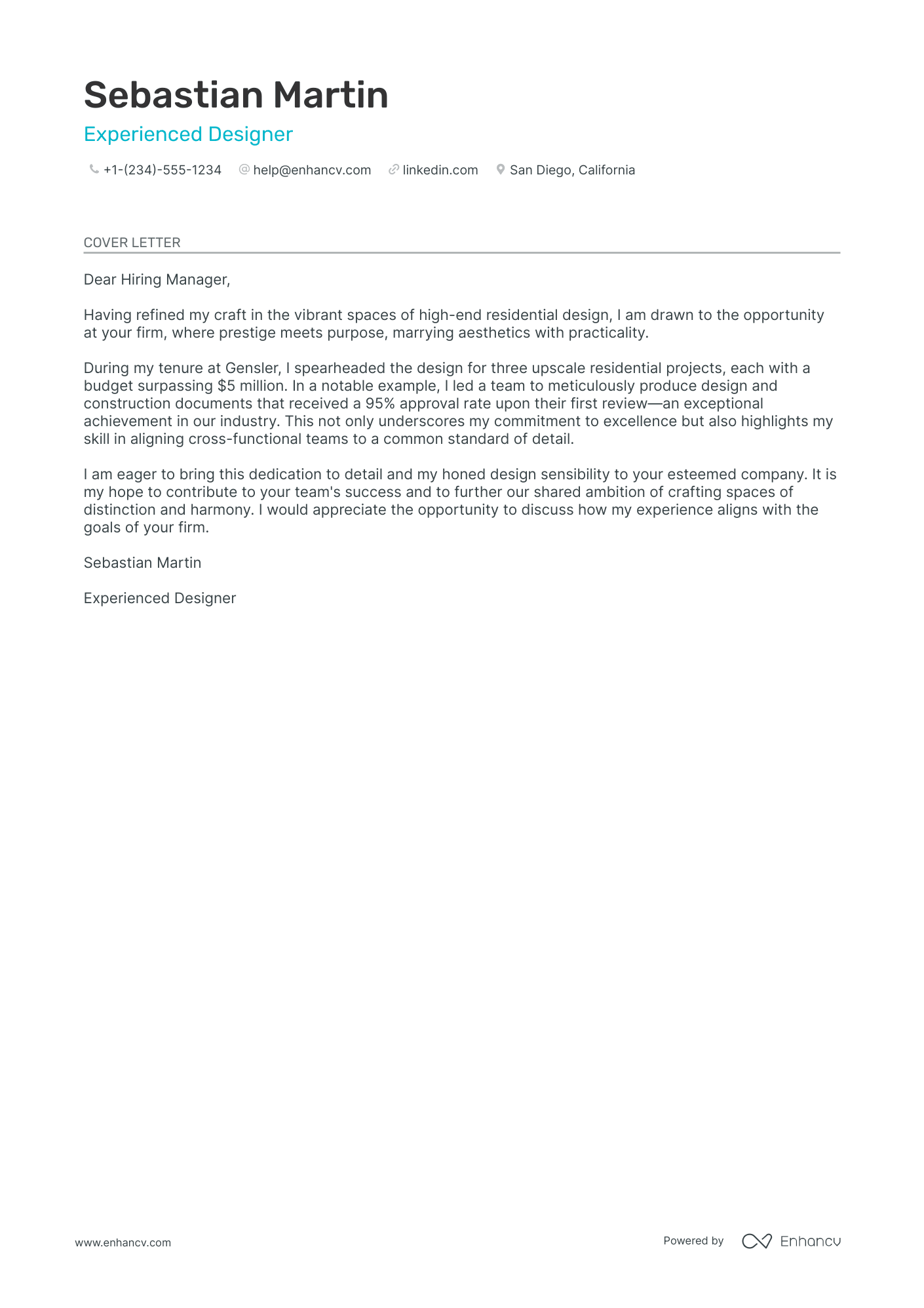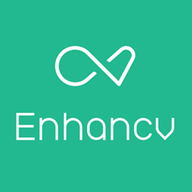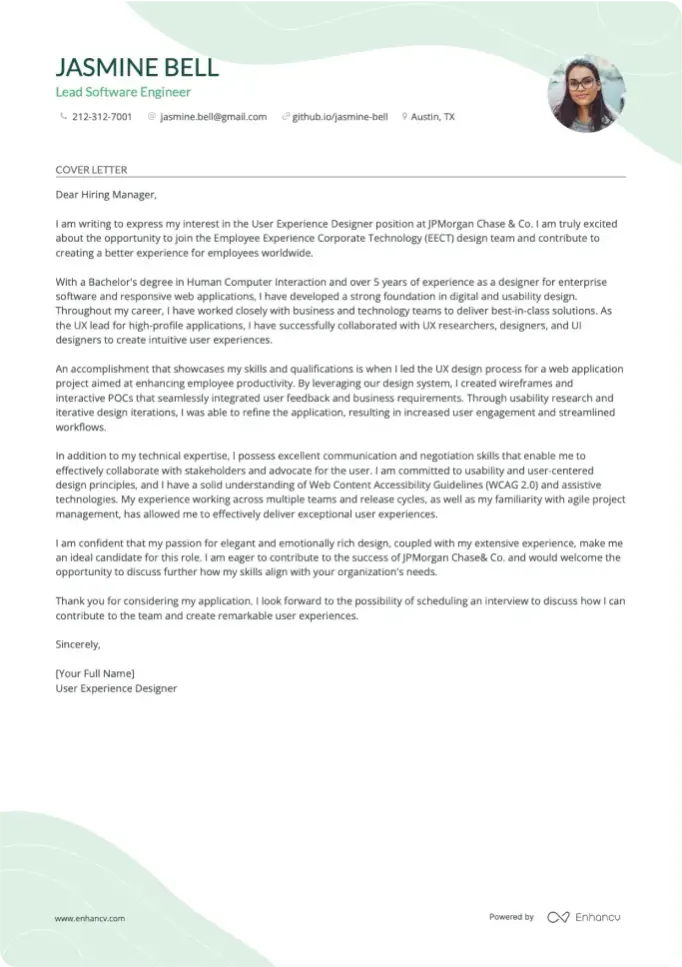Crafting an interior designer cover letter can feel like arranging furniture in a room where the pieces don't quite fit. You’re eager to apply for an inspiring role, yet puzzled by the task of presenting your unique professional story without simply echoing your resume. Your narrative should highlight a signature achievement, steering clear of worn-out phrases while maintaining a formal tone in a concise, one-page masterpiece. Let's guide you through the process of showcasing your flair in a way that feels both personal and polished.
- Introduce your profile to catch recruiters' attention;
- Use professional templates and examples to make sure your interior designer cover letter follows the best industry standards;
- Settle on your most story-worthy achievement to shine a light on what makes your application unique;
- Write a interior designer cover letter, even when you lack professional experience.
Ready to start with the basics: upload your resume to Enhancv's AI, below, to see the interior designer cover letter it would write for you.
If the interior designer isn't exactly the one you're looking for we have a plethora of cover letter examples for jobs like this one:
Drop your resume here or choose a file.
PDF & DOCX only. Max 2MB file size.
Interior designer cover letter example
Taylor Foster
New York, NY
+1-(234)-555-1234
help@enhancv.com
- Demonstration of relevant experience with specific examples, like the successful management of a project involving 30 suppliers and the launch of 12 greenfield implantations, showcases the candidate's ability to handle complex and large-scale projects in an urban garden design capacity.
- Alignment of personal values with the company's mission, emphasizing the candidate's passion for environmental stewardship and sustainable design, which reinforces their suitability for a role in a company focusing on eco-conscious development.
- Offer of further discussion on skill sets and certifications during an interview, indicating the candidate's preparedness to elaborate on how their qualifications specifically align with the job requirements and company goals.
What should your interior designer cover letter look like - formatting and organizing your information
Have you ever wondered what are the must-have sections you need to include in your interior designer cover letter? Our builder sets those up for you with:
- Header - dedicated to your contact information, the role you're applying for, and the date (don't forget to include your name);
- Greeting and opening paragraph - to create a personalized and memorable experience for recruiters;
- Body paragraph - emphasizing your skill set and knowledge that aligns with the role and helps you to stand out;
- Closing paragraph - leaving a great impression and ending with an optional signature.
Use a cover letter template to discover the best formatting for your interior designer cover letter: that is single-spaced paragraphs and wrapping your content in a one-inch margin.
Ensure that both your resume and interior designer cover letter are in the same font. Stand apart from the crowd by using modern, yet simple fonts, like Chivo and Rubik, instead of the overused Arial and Times New Roman.
Did you know that the Applicant Tracker System (or ATS) won't be assessing your interior designer cover letter? Instead, submit your profile in PDF to recruiters to keep the same formatting and the design intact.
Writing a cover letter is easy with our free cover letter generator. Make one in seconds from your resume.
The top sections on a interior designer cover letter
- Header: Include your name, contact information, and date, which is crucial for the hiring manager to know who you are and how to reach you for an interview.
- Greeting: Address the hiring manager or the head of the interior design department directly if possible to create a personal touch and demonstrate your attention to detail.
- Introduction: Briefly express your enthusiasm for interior design and mention any specific project or style that aligns with the hiring company’s portfolio, indicating your familiarity with their work.
- Body: Highlight your most significant design projects, the range of your design skills, understanding of materials and trends, as well as client satisfaction rates to showcase your hands-on experience and successful track record.
- Closing: Reiterate your passion for interior design, your fit for the company's aesthetic and culture, and a call to action, such as looking forward to discussing how you can contribute to their team's success.
Key qualities recruiters search for in a candidate’s cover letter
- Proficiency with design software (e.g., AutoCAD, SketchUp, Revit, Adobe Creative Suite): Important for creating accurate and detailed design plans and visualizations.
- Strong portfolio showcasing a variety of design styles: Demonstrates versatility, creativity, and a track record of meeting clients’ aesthetic and functional needs.
- Knowledge of building codes and regulations: Critical for ensuring that designs comply with all safety and legal standards.
- Exceptional spatial awareness and attention to detail: Enables the creation of functional, aesthetically pleasing spaces that maximize utility while maintaining design integrity.
- Excellent communication and client relationship skills: Essential for understanding client visions, presenting design concepts, and ensuring client satisfaction throughout the design process.
- Project management experience: Shows the ability to coordinate with contractors, manage timelines, and stay within budget, leading to successful project completion.
How to greet recruiters in your interior designer cover letter salutation
As the saying goes, "You never get a second chance to make a first impression."
Write your interior designer cover letter salutation to be more personalized to the actual hiring manager, who is set to assess your profile by:
- greeting them on a first-name basis, if you have previously communicated with them (e.g. "Dear Sam,");
- using their last name, if you have more formal communication or haven't spoken to them (e.g. "Dear Mr. Harrows" or "Dear Ms. Marshall");
- writing "Dear HR Team" or "Dear Hiring Manager", if you have no clue about who's recruiting for the role.
Search on LinkedIn, Google, or the company website to find information as to the recruiter's name.
In any case, avoid the impersonal "Dear Sir or Madam".
List of salutations you can use
- Dear Hiring Manager,
- Dear [Name of the Design Firm] Team,
- Dear [Specific Name of the Hiring Manager],
- Dear [Name of the Department] Hiring Committee,
- Dear [Mr./Ms./Dr.] [Last Name],
- Dear Selection Committee,
Introducing your profile to catch recruiters' attention in no more than two sentences
The introduction of your interior designer cover letter is a whole Catch 22 .
You have an allocated space of no more than just a paragraph (of up to two sentences). With your introduction, you have to stand out and show why you're the best candidate out there.
Set out on a journey with your interior designer cover letter by focusing on why you're passionate about the job. Match your personal skills and interests to the role.
Another option for your interior designer cover letter introduction is to show you're the ideal candidate. Write about how your achievements and skills are precisely what the company is looking for.
However you decide to start your interior designer cover letter, always remember to write about the value you'd bring about. Making it both tangible (with your metrics of success) and highly sought out.
What to write in the body of your interior designer cover letter
Now that you've got your intro covered, here comes the heart and soul of your interior designer cover letter.
It's time to write the middle or body paragraphs. This is the space where you talk about your relevant talent in terms of hard skills (or technologies) and soft (or people and communication) skills.
Keep in mind that the cover letter has a different purpose from your interior designer resume.
Yes, you still have to be able to show recruiters what makes your experience unique (and applicable) to the role.
But, instead of just listing skills, aim to tell a story of your one, greatest accomplishment.
Select your achievement that:
- covers job-crucial skills;
- can be measured with tangible metrics;
- shows you in the best light.
Use the next three to six paragraphs to detail what this success has taught you, and also to sell your profile.
A sincere and original way to end your interior designer cover letter
When writing their interior designer cover letter, candidates tend to use one of these phrases, "Sincerely yours" or "I look forward to hearing from you".
Both statements show good manners, but your cover letter should end in a more actionable manner.
Write about:
- how you see yourself growing in the role/organization;
- the benefits you would bring about (you'd impress even more with tangible metrics);
- the next steps in the process (provide your availability for interviews).
Is it beneficial to mention that you have no experience in your interior designer cover letter?
Lacking professional experience isn't the end of the world for your interior designer cover letter.
Just be honest that you may not have had roles in the industry, but bring about so much more.
Like, your transferable skills, attained thanks to your whole work and life experience (e.g. the skills your summer spent working abroad taught you).
Or, focus on what makes you, you, and that one past success that can help you stand out and impress recruiters (think of awards you've attained and how they've helped you become a better professional).
Alternatively, write about your passion and drive to land the job and the unique skill set you would bring to enhance the workplace culture.
Key takeaways
Winning at your job application game starts with a clear and concise interior designer cover letter that:
- Has single-spaced paragraphs, is wrapped in a one-inch margin, and uses the same font as the interior designer resume;
- Is personalized to the recruiter (using their name in the greeting) and the role (focusing on your one key achievement that answers job requirements);
- Includes an introduction that helps you stand out and show what value you'd bring to the company;
- Substitutes your lack of experience with an outside-of-work success, that has taught you valuable skills;
- Ends with a call for follow-up or hints at how you'd improve the organization, team, or role.
Interior Designer cover letter examples
By Experience
Entry-Level Interior Design
Senior Interior Design
By Role








